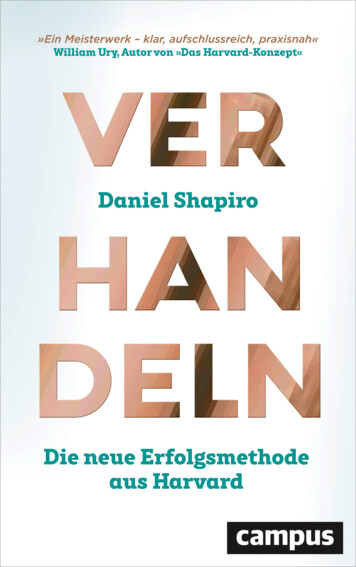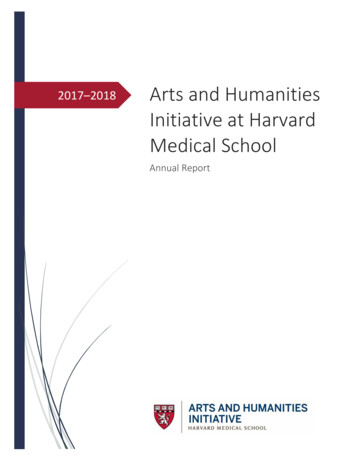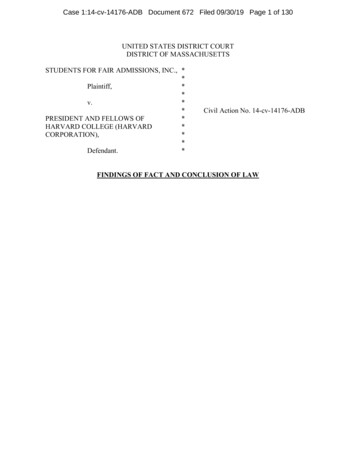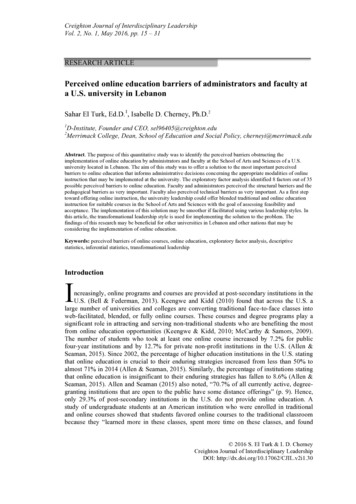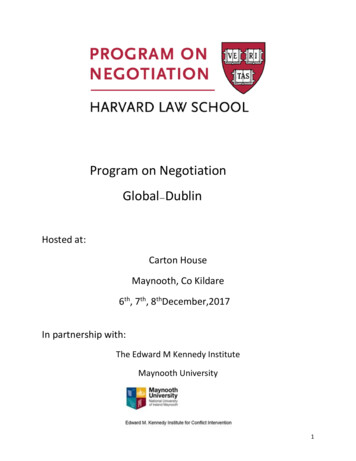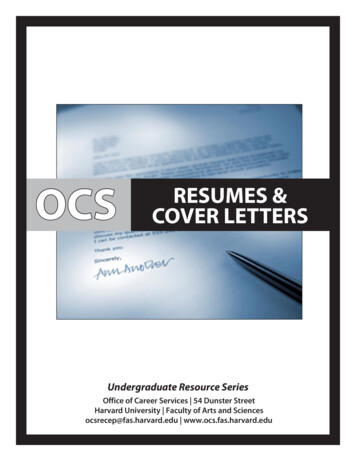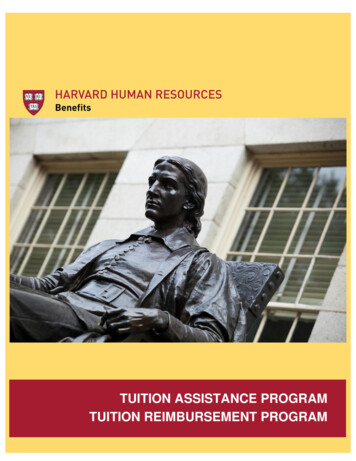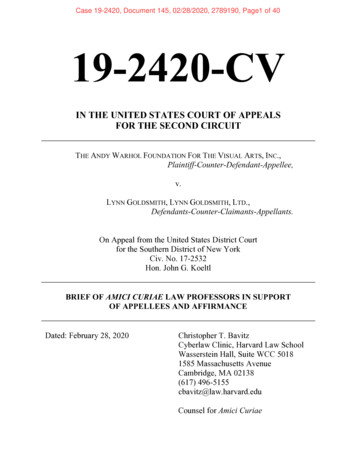
Transcription
Case 19-2420, Document 145, 02/28/2020, 2789190, Page1 of 4019-2420-CVIN THE UNITED STATES COURT OF APPEALSFOR THE SECOND CIRCUITTHE ANDY WARHOL FOUNDATION FOR THE VISUAL ARTS, INC.,Plaintiff-Counter-Defendant-Appellee,v.LYNN GOLDSMITH, LYNN GOLDSMITH, LTD.,Defendants-Counter-Claimants-Appellants.On Appeal from the United States District Courtfor the Southern District of New YorkCiv. No. 17-2532Hon. John G. KoeltlBRIEF OF AMICI CURIAE LAW PROFESSORS IN SUPPORTOF APPELLEES AND AFFIRMANCEDated: February 28, 2020Christopher T. BavitzCyberlaw Clinic, Harvard Law SchoolWasserstein Hall, Suite WCC 50181585 Massachusetts AvenueCambridge, MA 02138(617) 496-5155cbavitz@law.harvard.eduCounsel for Amici Curiae
Case 19-2420, Document 145, 02/28/2020, 2789190, Page2 of 40CORPORATE DISCLOSURE STATEMENTPursuant to Rule 26.1 of the Federal Rules of Appellate Procedure, amicicuriae Law Professors each state that they are individuals.Dated: February 28, 2020By: /s/ Christopher T. BavitzChristopher T. BavitzCounsel for Amici Curiaei
Case 19-2420, Document 145, 02/28/2020, 2789190, Page3 of 40TABLE OF CONTENTSPageCORPORATE DISCLOSURE STATEMENT . iTABLE OF CONTENTS . iiTABLE OF AUTHORITIES . iiiSTATEMENT OF INTEREST OF AMICI CURIAE . 1SUMMARY OF ARGUMENT . 3ARGUMENT . 5I. Recognizable Similarity in Expression is Not, in Itself, SubstantialSimilarity. . 5II. There is No Substantial Similarity Between the Goldsmith Photo and thePrince Series. 7A. Substantial Similarity Only Considers Similarity BetweenCopyrightable Elements. . 7B. Because the Goldsmith Photo Is A Mixture of Factual and CreativeContent, Only Limited Aspects of It Are Protectable Under Copyright. . 9C. Courts Have Repeatedly Held That Works Are Not SubstantiallySimilar Despite Copying in Fact, Where the Works Have DifferentAesthetics. . 11III. Substantial Similarity Is a Stronger Basis for the Ruling Here Because ItClarifies the Scope of the Plaintiff’s Rights and Lessens the Burden onDefendants in Similar Situations. . 27CONCLUSION . 32CERTIFICATE OF COMPLIANCE . 33CERTIFICATE OF SERVICE . 34ii
Case 19-2420, Document 145, 02/28/2020, 2789190, Page4 of 40TABLE OF AUTHORITIESCASESAndy Warhol Found. for the Visual Arts v. Goldsmith,382 F. Supp. 3d 312 (S.D.N.Y. 2019) . passimArnstein v. Porter,154 F.2d 464 (2d Cir. 1946) . 3Bill Diodato Photography, LLC v. Kate Spade, LLC,388 F. Supp. 2d 382 (S.D.N.Y. 2005) . 10Boisson v. Banian, Ltd.,273 F.3d 262 (2d Cir. 2001) . 7, 9, 26, 29Campbell v. Acuff-Rose Music, Inc.,510 U.S. 569 (1994) . 27, 29Dyer v. Napier, No. CIV 04-0408-PHX-SMM,2006 WL 2730747 (D. Ariz. Sept. 25, 2006). 18, 19, 24Eden Toys, Inc. v. Marshall Field & Co.,675 F.2d 498 (2d Cir.1982) . 28Feist Publ’ns, Inc. v. Rural Tel. Serv. Co.,499 U.S. 340 (1991) . 24Fisher-Price, Inc. v. Well-Made Toy Mfg. Corp.,25 F.3d 119 (2d Cir. 1994). . 5Franklin Mint Corp. v. Nat’l Wildlife Art Exch., Inc.,575 F.2d 62 (3d Cir. 1978) . 10Gary Friedrich Enter., LLC v. Marvel Characters, Inc.,716 F.3d 302 (2d Cir. 2013) . 5Hamil Am. Inc. v. GFI,193 F.3d 92 (2d Cir. 1999) . 8Harney v. Sony Pictures Television, Inc.,704 F.3d 173 (1st Cir. 2013) . 13, 14, 15iii
Case 19-2420, Document 145, 02/28/2020, 2789190, Page5 of 40Kerr v. New Yorker Magazine, Inc.,63 F. Supp. 2d 320, (S.D.N.Y. 1999). . 17, 18Key Publ’ns, Inc. v. Chinatown Today Publ’g Enters., Inc.,945 F.2d 509 (2d Cir. 1991) . 8Kienitz v. Sconnie Nation LLC,766 F.3d 756 (7th Cir. 2014) . 24, 25, 31Laureyssens v. Idea Grp., Inc.,964 F.2d 131 (2d Cir. 1992) . 8Leibovitz v. Paramount Pictures Corp.,137 F.3d 109 (2d Cir. 1998) . 11Mannion v. Coors Brewing Co.,377 F. Supp. 2d 444 (S.D.N.Y. 2005) . 20, 21, 24Mattel, Inc. v. MGA Entm’t, Inc.,616 F.3d 904 (9th Cir. 2010) . 28Matthew Bender & Co., Inc. v. West Publ’g Co.,158 F.3d 693 (2d Cir. 1998) . 27McElwee v. Cnty. of Orange,700 F.3d 635 (2d Cir. 2012) . 5Peter F. Gaito Architecture, LLC v. Simone Dev. Corp.,602 F.3d 57 (2d Cir. 2010) . 5, 9, 29Peter Pan Fabrics, Inc. v. Martin Weiner Corp.,274 F.2d 487 (2d Cir. 1960). . 6Psihoyos v. Nat'l Geographic Soc'y,409 F. Supp. 2d 268 (S.D.N.Y. 2005) . 10, 16, 26Reece v. Island Treasures Art Gallery, Inc.,468 F.Supp.2d 1197 (D. Haw. 2006) . 15, 16, 26Rentmeester v. Nike, Inc.,883 F.3d 1111 (9th Cir. 2018) . 4, 11, 12, 13iv
Case 19-2420, Document 145, 02/28/2020, 2789190, Page6 of 40Rogers v. Koons,960 F.2d 301 (2d Cir. 1992) . 9, 11Saturday Evening Post Co. v. Rumbleseat Press, Inc.,816 F.2d 1191 (7th Cir.1987) . 28Tufenkian Import/Export Ventures, Inc. v. Einstein Moomjy, Inc.,338 F.3d 127 (2d Cir. 2003) . 3, 8, 9Warner Bros. Inc. v. American Broadcasting Cos., Inc.,720 F.2d 231 (2d Cir. 1983) (“Warner Bros. II”) . passimWarner Bros. Inc. v. American Brodcasting Cos., Inc.,654 F.2d 204 (2d Cir. 1981) (“Warner Bros. I”). 6, 28Williams v. Crichton,84 F.3d 581 (2d Cir. 1996) . 4, 9OTHER AUTHORITIESHon. Sir Hugh Laddie et al.,1 The Modern Law of Copyright and Designs (3d ed. Butterworths 2000) . 20Joseph P. Liu, Copyright and Breathing Space,30 Colum. J.L. & Arts 429 (2007). 31Melville B. Nimmer & David Nimmer,Nimmer on Copyright (1983) . 3Melville B. Nimmer & David Nimmer,Nimmer on Copyright (2019) .10, 20, 28, 30Oren Bracha & John M. Golden, Redundancy and Anti-Redundancy in Copyright,51 Conn. L. Rev. 247, 279 (2019) . 29, 30Oren Bracha, Not De Minimis: (Improper) Appropriation in Copyright,68 Am. U. L. Rev. 139 (2018). 7, 30v
Case 19-2420, Document 145, 02/28/2020, 2789190, Page7 of 40STATEMENT OF INTEREST OF AMICI CURIAEAmici are scholars whose research and teaching focus is copyright law.1Amici have no direct interest in the outcome of this litigation2 Although amicistrongly support the application of fair use in this case, they write here toemphasize that this is also a substantial similarity case, and that substantialsimilarity has an important role to play in establishing the scope of copyright thatshould not be wholly delegated to fair use, even when copying in fact isundisputed. Amici include:Jonathan AskinProfessor of Clinical LawBrooklyn Law SchoolOren BrachaWilliam C. Conner Chair in LawThe University of Texas School of LawSonya G. BonneauProfessor of Law, Legal PracticeGeorgetown University Law Center1Pursuant to Federal Rule of Appellate Procedure 29(a)(4)(E), amici certify that noparty’s counsel authored this brief in whole or in part; no party or party’s counselcontributed money that was intended to fund the preparation or submission of thisbrief; and no person — other than the amici, their members, or their counsel —contributed money that was intended to fund the preparation or submission of thisbrief. Pursuant to Federal Rule of Appellate Procedure 29(a)(2), all parties haveconsented to the filing of this brief.2Amici’s institutional affiliations are provided only for purposes of identification.1
Case 19-2420, Document 145, 02/28/2020, 2789190, Page8 of 40Dr. Carys J. CraigAssociate Professor of LawOsgoode Hall Law School, York UniversityJames GibsonSesquicentennial Professor of LawUniversity of RichmondJames GrimmelmannProfessor of LawCornell Tech and Cornell Law SchoolLaura A. HeymannChancellor Professor of LawWilliam & Mary Law SchoolStacey M. LantagneAssociate Dean for Faculty DevelopmentAssociate Professor of LawThe University of Mississippi School of LawMark LemleyWilliam H. Neukom Professor of LawStanford Law SchoolJessica LitmanJohn F. Nickoll Professor of LawThe University of Michigan Law SchoolZahr K. SaidAssociate Dean for Faculty Research and DevelopmentCharles I. Stone Professor of LawUniversity of Washington School of Law2
Case 19-2420, Document 145, 02/28/2020, 2789190, Page9 of 40Jessica SilbeyProfessor of Law, Northeastern University School of LawFaculty Director, Center for Law, Innovation and Creativity (CLIC),Northeastern UniversityRebecca TushnetFrank Stanton Professor of First AmendmentHarvard Law SchoolJennifer M. UrbanClinical Professor of LawUniversity of California, Berkeley, School of LawSUMMARY OF ARGUMENTIt is well established that there can be copying without infringement. SeeTufenkian Import/Export Ventures, Inc. v. Einstein Moomjy, Inc., 338 F.3d 127,134-35 (2d Cir. 2003) (“The court, confronted with an allegedly infringing work,must . . . determine whether . . . similarities are due to protected expressions . . . or,whether the similarity is something in the original that is free for the taking”); cf.Arnstein v. Porter, 154 F.2d 464, 472 (2d Cir. 1946) (“Assuming that adequateproof is made of copying, that is not enough; for there can be ‘permissiblecopying.’”). In other words, “a defendant may legitimately avoid infringement byintentionally making sufficient changes in a work which would otherwise beregarded as substantially similar to that of the plaintiff’s.” Warner Bros. Inc. v.American Broadcasting Cos., Inc., 720 F.2d 231, 241 (2d Cir. 1983) (“WarnerBros. II”) (quoting 3 Melville B. Nimmer & David Nimmer, Nimmer on Copyright§ 13.03[B] (1983)). If it were otherwise, absent another defense, Jurassic Park3
Case 19-2420, Document 145, 02/28/2020, 2789190, Page10 of 40might infringe upon a story involving shenanigans on a dinosaur island, thecopyright holders of the character Superman could prevent others from creating asuperhero who is super strong and flies around in a cape and primary-colored suit,and no one else could take a photograph of Michael Jordan leaping without JacobRentmeeseter’s permission. See Williams v. Crichton, 84 F.3d 581 (2d Cir. 1996);Warner Bros. II, 720 F.2d 231; Rentmeester v. Nike, Inc., 883 F.3d 1111 (9th Cir.2018).Like those examples, Warhol’s Prince Series has similarities with theunderlying photograph of Prince taken by Lynn Goldsmith, but inspection revealsthat the overall aesthetic impression of the Warhol Prince Series is completelydifferent from the Goldsmith photograph. The dramatic divergence in visualrendition makes the two works not substantially similar. Although the district courtwas correct to grant summary judgment in favor of Warhol, Andy Warhol Found.for the Visual Arts, Inc. v. Goldsmith, 382 F. Supp. 3d 312, 331 (S.D.N.Y. 2019),traditional infringement analysis is a more fundamental ground on which to decidethis case than fair use.Fair use is a valuable and flexible tool for realizing the goals of copyright.However, there is no need to use a Swiss Army knife when a simpler implement —traditional infringement analysis — will do. No matter what its purpose or effecton the market, a work that is not substantially similar in its use of copyrightable4
Case 19-2420, Document 145, 02/28/2020, 2789190, Page11 of 40elements from the original simply does not infringe. Holding such instances to befair use may mitigate the damage, but it makes the fair use doctrine morecomplicated and implicitly suggests that the defendants in such cases did takeenough to infringe, which encourages future plaintiffs to try their luck withaggressive copyright claims. It is for this reason that this Court should affirm thedistrict court on the ground that the two works are not substantially similar, ratherthan relying — as the district court did — on fair use. See Gary Friedrich Enter.,LLC v. Marvel Characters, Inc., 716 F.3d 302, 316 (2d Cir. 2013) (quotingMcElwee v. Cnty. of Orange, 700 F.3d 635, 640 (2d Cir. 2012)) (“We may affirmthe district court's order granting summary judgment ‘on any ground supported bythe record, even if it is not one on which the district court relied’”).ARGUMENTI.Recognizable Similarity in Expression is Not, in Itself, SubstantialSimilarity.Not all copying in fact is copyright infringement. Peter F. GaitoArchitecture, LLC v. Simone Dev. Corp., 602 F.3d 57, 63 (2d Cir. 2010). To incurliability, the defendant must copy enough expression to make the accused worksubstantially similar to the protectable elements of the copyright claimant’s work.Fisher-Price, Inc. v. Well-Made Toy Mfg. Corp., 25 F.3d 119, 123 (2d Cir. 1994).The standard this Court has set forth is “substantial” similarity — not anysimilarity in expression, not even recognizable similarity in expression, but a5
Case 19-2420, Document 145, 02/28/2020, 2789190, Page12 of 40similarity that substantially duplicates the aesthetic appeal of the original. SeePeter Pan Fabrics, Inc. v. Martin Weiner Corp., 274 F.2d 487, 489 (2d Cir. 1960).Accordingly, summary judgment can be appropriate “either because the similaritybetween two works concerns only ‘non-copyrightable elements of the plaintiff’swork,’ . . . or because no reasonable jury, properly instructed, could find that thetwo works are substantially similar.” Warner Bros. II, 720 F.2d at 240 (internalquotations omitted; second emphasis added).For example, in Warner Bros. II, this Court recognized that Ralph Hinkley’scharacter in the show “The Greatest American Hero” had powerful similarities toSuperman: the show’s premise was literally “what happens when you [the averageperson] become Superman.” Id. at 236. But the two characters were notsubstantially similar, because the other features ABC introduced were combinedwith the copied features in a way that changed the overall aesthetic impression ofthe work. And this was true even though those copied features could still beseparately identified in ABC’s work by a list of shared characteristics. WarnerBros. Inc. v. American Brodcasting Cos., Inc., 654 F.2d 204, 209 (2d Cir. 1981)(“Warner Bros. I”).Because the substantial similarity requirement preserves subsequentcreators’ freedom to draw on the existing world, it is “the main doctrinal safeguardagainst copyright becoming a drag on the creative innovation it was meant to6
Case 19-2420, Document 145, 02/28/2020, 2789190, Page13 of 40promote.” Oren Bracha, Not De Minimis: (Improper) Appropriation in Copyright,68 Am. U. L. Rev. 139, 180 (2018). In Warner Bros. II, as Bracha explains, “[t]heimproper appropriation analysis required comparing the expressive content of thetwo works and discerning the material differences in their meaning,notwithstanding the technical similarities. This relatively simple analysis trackedwell the underlying policy question.” Id. at 194. And this relatively simple analysisis all that is required here.II.There is No Substantial Similarity Between the Goldsmith Photo andthe Prince Series.Warhol’s Prince Series removed, recolored, stylized, and otherwise alteredthe protectable creative elements of the Goldsmith Photo, precluding a finding ofsubstantial similarity. While there are overlapping visual elements between the twoworks, such as the appearance of Prince’s face, these elements are non-protectableand should not be part of a substantial similarity analysis.A. Substantial Similarity Only Considers Similarity BetweenCopyrightable Elements.When the similarities between two works stem at least in part fromunprotectable elements, this Court asks whether a “more discerning observer”would find substantial similarity. Boisson v. Banian, Ltd., 273 F.3d 262, 272 (2dCir. 2001) (“[A] ‘more refined analysis’ is required where a plaintiff’s work is not‘wholly original’ but rather incorporates elements of from the public domain.”).7
Case 19-2420, Document 145, 02/28/2020, 2789190, Page14 of 40This test “requires the court to eliminate the unprotectable elements from itsconsideration and ask whether the protectable elements, standing alone, aresubstantially similar.” Hamil Am. Inc. v. GFI, 193 F.3d 92, 101 (2d Cir. 1999); seealso Key Publ’ns, Inc. v. Chinatown Today Publ’g Enters., Inc., 945 F.2d 509, 514(2d Cir. 1991) ( “What must be shown is substantial similarity between thoseelements, and only those elements, that provide copyrightability to the allegedlyinfringed compilation.”).Because the Goldsmith Photo is a mixture of factual, non-protectableelements and creative, protectable choices, the Court should apply the morediscerning observer standard. See Laureyssens v. Idea Grp., Inc., 964 F.2d 131,141 (2d Cir. 1992) (“[W]here a design contains both protectible and unprotectibleelements, we have held that the observer’s inspection must be more discerning.”)(internal quotation omitted). However, regardless of how the observer is defined,the relevant comparison is between the protectable elements of the works;similarities between non-copyrightable elements should not bear weight in theanalysis.When comparing protectable elements under the more discerning observertest, this Court has emphasized that the two works must also be substantiallysimilar in “total concept and feel.” See Tufenkian, 338 F.3d at 134. (“[T]he totalconcept-and-feel locution functions as a reminder that, while the infringement8
Case 19-2420, Document 145, 02/28/2020, 2789190, Page15 of 40analysis must begin by dissecting the copyrighted work into its component parts . ., infringement analysis is not simply a matter of ascertaining similarity betweencomponents viewed in isolation.”) (emphasis in original). This test considers theworks’ “overall aesthetic” in determining whether there is infringement. Id. at 130.In assessing the total aesthetic impression, this Court often considers whether thetone or theme of the works being compared is similar. See, e.g., Boisson, 273 F.3dat 273; Williams, 84 F.3d at 589. By capturing when a protectable arrangement ofunprotectable elements creates a distinct aesthetic impression, this test protectsagainst dissecting a work into unprotectable elements in a way that misses theforest for the trees. See Boisson, 273 F.3d at 272. Reciprocally, similarity betweenthe constituent elements of two works does not amount to copyright infringementif the total concept and feel is fundamentally different. See, e.g., Warner Bros. II,720 F.2d at 241; Boisson, 273 F.3d at 276; Peter F. Gaito Architecture, 602 F.3d at67.B. Because the Goldsmith Photo Is A Mixture of Factual andCreative Content, Only Limited Aspects of It Are ProtectableUnder Copyright.The copyright in the Goldsmith Photo extends only to the elements whichare original and result from Goldsmith’s own creative choices. See Rogers v.Koons, 960 F.2d 301, 307 (2d Cir. 1992). Much of what makes the GoldsmithPhoto identifiable as the starting point for the Prince Series is non-copyrightable9
Case 19-2420, Document 145, 02/28/2020, 2789190, Page16 of 40content. For instance, the most prominent feature of the Goldsmith Photo, theshape of Prince’s face and hair, is not protectable. Psihoyos v. Nat'l GeographicSoc'y, 409 F. Supp. 2d 268, 275 (S.D.N.Y. 2005) (“A copyright in a photographderives from the photographer’s original conception of his subject, not the subjectitself.”) (citation omitted); Franklin Mint Corp. v. Nat’l Wildlife Art Exch., Inc.,575 F.2d 62, 65 (3d Cir. 1978) (artists have a “weak” copyright claim when the“reality of [their] subject matter” is not easily separable from their artisticexpression of it); 4 Melville B. Nimmer & David Nimmer, Nimmer on Copyright §13.03[B][2][b] (2019) (noting that appearance of objects in the public domain oras they occur in nature is not protected by copyright).Similarly, Prince’s pose of staring straight into the camera, to the extent thatit is a product of Goldsmith’s creative direction, is not protectable. The pose ishardly uncommon and is a scène à faire. See Pl.’s Mem. of Law Supp. Mot. Summ.J. at 34, Andy Warhol Found. for the Visual Arts v. Goldsmith, 382 F. Supp. 3d 312(S.D.N.Y. 2019) (finding multiple pictures of Prince staring forward into thecamera); see also Bill Diodato Photography, LLC v. Kate Spade, LLC, 388 F.Supp. 2d 382, 392 (S.D.N.Y. 2005) (holding that the contorted pose of a seatedwoman’s feet viewed from a low perspective looking under a bathroom stall isscène à faire and not copyrightable).10
Case 19-2420, Document 145, 02/28/2020, 2789190, Page17 of 40Goldsmith does have a copyright in the product of the artistic choices shemade in shooting Prince. Depending on the content of a given photograph, thesemay include originality in “posing the subjects, lighting, angle, selection of filmand camera, evoking the desired expression, and almost any other variantinvolved.” Rogers, 960 F.2d at 307; see also Leibovitz v. Paramount PicturesCorp., 137 F.3d 109, 116 (2d Cir. 1998) (holding there was protection for “suchartistic elements as the particular lighting, the resulting skin tone of the subject,and the camera angle”). Assuming that Goldsmith’s direction created sufficientlyoriginal effects, it is the selection and arrangement of these artistic choices that isprotectable, “not any of the individual elements standing alone.” Rentmeester, 883F.3d at 1119. So too with the characteristics that made it eventually possible toidentify the Goldsmith photograph as the reference for the Warhol Series — theglint in Prince’s eye is not the same thing as the protectable combination oflighting, camera, and angle that produced the glint.C. Courts Have Repeatedly Held That Works Are Not SubstantiallySimilar Despite Copying in Fact, Where the Works HaveDifferent Aesthetics.Copying in fact produces similarity. But that alone does not establishinfringement. Multiple decisions have affirmed that there is no substantialsimilarity between two visual works whose similarities stem largely fromunprotectable elements. For example, the Ninth Circuit found no substantial11
Case 19-2420, Document 145, 02/28/2020, 2789190, Page18 of 40similarity between two photographs, one “obviously inspired” by the other, ofMichael Jordan dunking a basketball in an unnatural ballet-esque leap pose.Rentmeester, 883 F.3d at 1116 (9th Cir. 2018).Plaintiff’s photo in Rentmeester. Id. at 1126.3Defendant’s Photo in Rentmeester. Id.3Defendant’s Logo. Id. at 1127.The images included in this brief are the highest resolution versions of the imagesavailable. The original version of the image can be found at the cited sources.12
Case 19-2420, Document 145, 02/28/2020, 2789190, Page19 of 40Despite finding that Jordan’s pose was “fanciful” and “highly original,” the courtheld that it was not protectable as such, and therefore the original photographercould not stop others from taking photographs of Jordan in a similar pose. Id. at1121. Importantly, the court noted a lack of similarity between the protectableelements — the combination of the lighting, background, and overall aesthetic ofthe photographs. Id. at 1121-23. The respective creative choices of Rentmeesterand Nike produced images that were “unmistakably different . . . in materialdetails.” Id. at 1122. With respect to Nike’s logo, its “stylized” appearance made iteven less similar. Id. at 1123.More generally, there is no substantial similarity as a matter of law for visualworks that have overlapping, mostly unprotectable elements, but differ in otherprotectable elements, such as coloring, lighting, and background, in ways thatproduce an overall different aesthetic “look and feel.” A survey of the casesdemonstrates that aesthetic shifts regularly preclude substantial similarity where awork copies both protectable and unprotectable elements.For example, the First Circuit found no substantial similarity between aphotograph and an image that sought to recreate it. Harney v. Sony PicturesTelevision, Inc., 704 F.3d 173 (1st Cir. 2013). The plaintiff in that case, DonaldHarney, snapped a picture of a young girl riding on her father’s shoulders. Id. at13
Case 19-2420, Document 145, 02/28/2020, 2789190, Page20 of 40177. Shortly after the photograph was taken, the father in the picture abducted hisdaughter, and Harney’s photograph became an “iconic image” of the crime. Id.Sony, the defendant, recreated its own version of Harney’s photograph for a madefor-television movie on the abduction.Defendant’s Photo. Id. at 189.Plaintiff’s Photo. Id.As the court noted, both images “share several important features.” Id. at177. They both feature a white man, wearing a suit, holding in his left arm severalpapers held at a forty-five-degree angle. Id. On the shoulders of each man sits ablonde-haired girl, wearing a long, baby pink jacket. Id. The pose, angle, andframing of the father and daughter in each photo are reminiscent of each other. Id.Yet, the court notes that almost none of these overlapping features are protectable.Those that were, such as the placement of the father/daughter duo in the center of14
Case 19-2420, Document 145, 02/28/2020, 2789190, Page21 of 40the photograph, only had “minimal originality and [provided] an insufficient basis,without more, to find substantial similarity.” Id. at 187. The court further noted thatthe protectable elements important to a finding of substantial similarity — such asthe “lighting and coloring” of the images — were different, giving them“aesthetically dissimilar impacts,” and precluded a jury finding of substantialsimilarity. Id.Reece v. Island Treasures Art Gallery, Inc., 468 F. Supp. 2d 1197 (D. Haw.2006), involved transferring an image of a hula dancer from photograph toabstracted stained glass. The court found there was no substantial similarity despitethe highly similar pose and angle. Id. at 1206-08.Plaintiff’s PhotographDefendant’s Stained-Glass Window15
Case 19-2420, Document 145, 02/28/2020, 2789190, Page22 of 40Permanent Injunction and Order of Dismissal with Prejudice at EX. B-C, Reece v.Island Treasures Art Gallery, Inc., 468 F. Supp. 2d 1197 (D. Haw. 2006) (No. 060049), ECF No. 96.The Reece court based its decision on, among other things, the smalldifference in the images’ protectable elements — the dancers’ angles, id. at 1207;the differing backgrounds, id.; and the lighting effects that were “unique” to thephoto, which created a contrast between dark and light and resulted in sepiashading “absent” from the stained glass, id. at 1208. Ultimately, the “absence ofdetail” in the stained glass, the differing backgrounds, differing hairstyles, and“marked[] contrast” between the sepia photo and “vibrant colors” of the stainedglass precluded substantial similarity. Id.Psihoyos likewise found the similar light source and perspective in twodrawings of dinosaurs insufficiently similar. 409 F. Supp. 2d at 278. The drawingshad other differences, including “significantly different” drawing styles — onedetailed and using bright colors, the other simpler and l
cbavitz@law.harvard.edu Counsel for Amici Curiae Case 19-2420, Document 145, 02/28/2020, 2789190, Page1 of 40 . strongly support the application of fair use in this case, they write here to . Harvard Law School Jennifer M. Urban Clinical Professor of Law University of California, Berk

